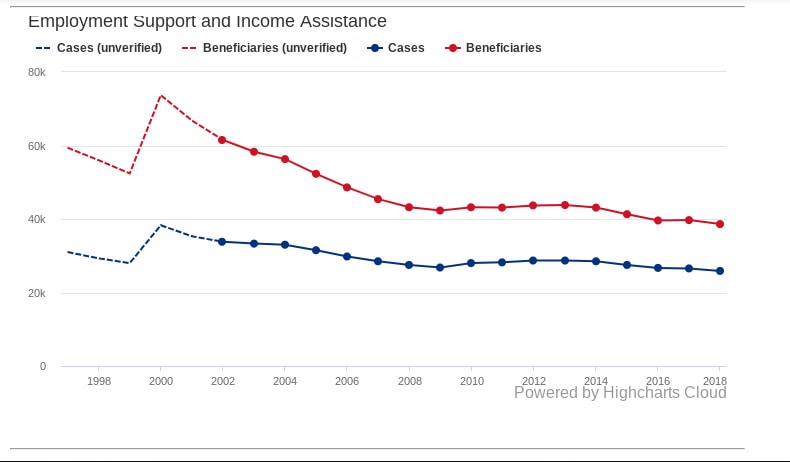KJIPUKTUK (Halifax) – The number of people receiving income assistance in Nova Scotia has been steadily decreasing over the last 6 to 7 years, and the Department of Community Services doesn’t seems to know why that is.
After peaking in the mid-2000s both the number of cases and beneficiaries has decreased consistently since 2013.
Mind you, not by a whole lot, but shedding between 700 to 1800 beneficiaries each year adds up.
In March 2018, both the number of cases (25,874) and beneficiaries (38,611) were at their lowest level for at least two decades. Beneficiaries are individual claimants, their partners, and dependent children. A grouping of beneficiaries, e.g. a family, represents a case.

The Nova Scotia numbers are part of the latest update of the Maytree Social Assistance Summaries, an annual report that compiles numbers for all provinces and territories.
Some provinces showed a fairly steep increase over previous years (e.g. Alberta), and other provinces fluctuate from year to year but are essentially steady (British Columbia). No other province appears to show a recent consistent decrease over a longer period similar to Nova Scotia.
| Year | Cases | Beneficiaries |
| 2013 | 28,700 | 43,800 |
| 2014 | 28,500 | 43,100 |
| 2015 | 27,500 | 41,300 |
| 2016 | 26,700 | 39,600 |
| 2017 | 26,550 | 39,700 |
| 2018 | 25,874 | 38,611 |
I asked the department of Community Services why this is so.
“The ESIA caseload fluctuates on a monthly basis as recipients enter and exit the system,” writes media relations advisor Shannon Kerr on behalf of the department.
“Caseload numbers can change for a number of reasons, including changes due to social and economic reasons, policy implementations, and the impact of changes to federal benefits. Over the last number of years, the overall decline in ESIA cases and beneficiaries is due to the caseload being made up of more single recipients than families,” Kerr writes.
The department does not explain what these “social and economic reasons, policy implementations and federal benefit changes” are, nor why they cause beneficiaries to leave the social assistance system behind.
Meanwhile, other statistical trends in Nova Scotia (child poverty, food bank use, census based income data, minimum wage) all suggest things aren’t getting much better for poor people. If anything you’d expect the number of income assistance cases to increase.
I just hope some of these people didn’t just go off the grid, so to speak, and abandoned the supports they are entitled to out of frustration with a system that many feel remains punitive in nature.
Maybe the department could ask people why they cut their ties with the income assistance system, and publish that information on say a yearly basis.
That would be good information to have.
Read the Maytree report on all provinces and territories. Check out the Nova Scotia data.
With a special thanks to our generous donors who make publication of the Nova Scotia Advocate possible.
Subscribe to the Nova Scotia Advocate weekly digest and never miss an article again. It’s free!




Since 2013, that’s 2826 less cases and 5189 less beneficiaries.
Maybe their plan to slowly starve us all to death is starting to show results. Of those 2826, how many died prematurely, say in their fifties, from illnesses that wouldn’t have occurred if they had far less stress and far more healthy food to eat? You can be sure that in this time frame, health care costs have skyrocketed as people get sick from poverty, and due to an aging population.
Another reason could be the slower birth rate, and of the adults left, many of us are reaching 65, which is when we get the boot from DCS.
“more single recipients than families” – This could be because if you have kids, government, charities, and society in general, has empathy and there are far more resources and help for families and little to nothing for single, childless persons. If I popped out a baby, people would be tripping over themselves to help me. I’d probably have a new wheelchair and a fully stocked house by the end of the week.
As for the increase in food bank use going up when the number of people on ESIA has gone down – I suggest that’s due to the cost of food going way up so people who might not have gone to a food bank 15 years ago are having to do so now. As well, the minimum wage has not kept up with inflation so the working poor are poorer and more of them are going to food banks. Tuition has gone up so more students would be as well.
Leaving aside a slowly improving economic situation, My guess is that the explanation for the steady decline in cases/beneficiaries is that many single parents are no longer bothering with IA if they can get by with other benefits—particularly the Canada Child Benefit.
“…policy implementations…” Indeed. As well, I second much of Ms. Lewis’ comments.